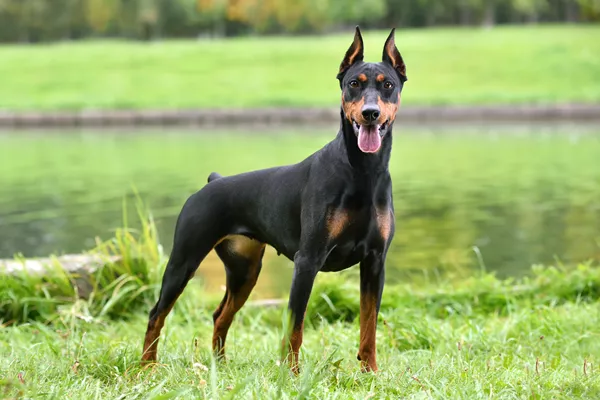
Like other Working Group dogs, German Pinschers are active and energetic. They need regular and consistent exercise so a fenced yard would be best, helping to curb negative behaviors. This breed is well-suited for many types of dog recreation and competition including obedience, rally, agility, barn hunt, lure coursing, scent work, nose work, tracking, dock diving, weight pull, herding, farm dog, and trick dog activities. They love lots of toys and will remain playful well past their first few years. Since they we bred for ratting and have a strong prey drive, they should be walked on a leash to keep them safe from chasing a nearby temptation.
This sleek, muscular, short-haired breed is low maintenance. Weekly brushing and the occasional bath will keep your German Pinscher's coat shiny and healthy. As with all dogs, nails should be trimmed every 3-4 weeks if they do not wear down naturally. Check ears weekly and clean if needed.
German Pinschers are very intelligent and assertive canines. They have the tendency to be strong-willed, so their pet parents need to be committed to training and being firm with them. It's important to find things for your German Pinscher to do to prevent boredom - interactive toys, filled toys with treats and activities like agility can help them be engaged and content. They love being with their family and do not like to be left alone for long periods of time. Since German Pinschers are so dedicated to their family, they make excellent guard dogs.
German Pinschers do well with children with whom they have been raised with as a puppy. This breed is also a good fit with children over the age of nine or ten. When adopting an older Pinscher who has not interacted with kids much, a home with older children who know how to properly interact with a dog would be best.
The exact origin of German Pinschers is unclear. Thought to have originated in southern Germany, botanist Heinrich Gottlieb Ludwig Reichenbach first mentioned the “smooth Pinscher” in 1836 and the breed was recorded in 1885. Often used as carriage dogs or stable dogs, they are excellent ratters.
They are one of Germany’s oldest breeds, previously starting out as one breed with two coat varieties: Wire-Haired Pinschers and Smooth-Haired Pinschers. In the early 1900s, the breed was officially divided. The Wire-Haired Pinscher became the Standard Schnauzer. The Smooth-Haired Pinscher became the German Pinscher, a foundation breed for both Doberman Pinschers and Miniature Pinschers.
The German Pinscher was imported to the US starting in the late 1970s. US Breeders started with German Pinschers from Germany, England, France, Sweden, Finland and Czechoslovakia. They began with a few litters and the popularity of the breed grew. In 2003, the American Kennel Club recognized the breed and accepted the German Pinscher into the Working Group.
The German Pinscher was recently noted as "endangered" by the Rote List, a German conservation organization that tracks threatened domestic breeds.